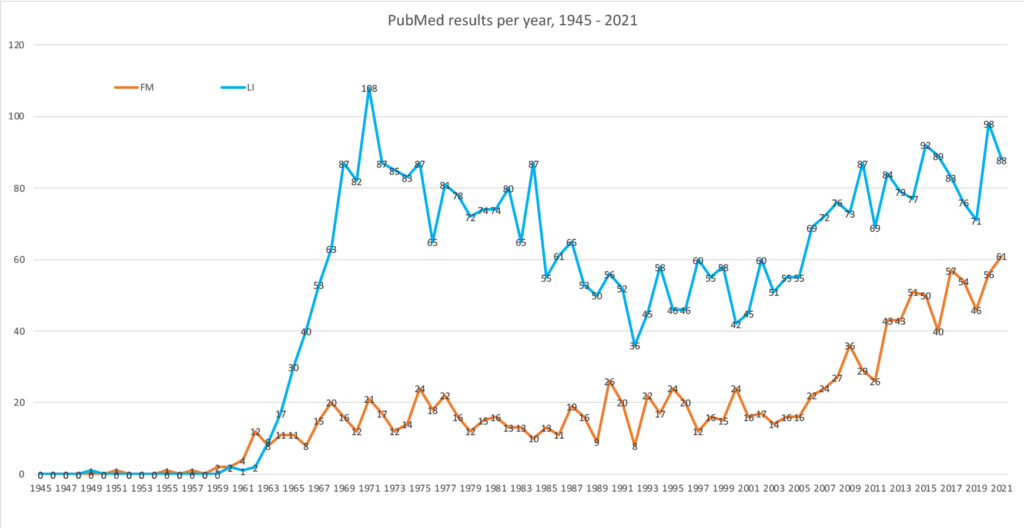Estimated reading time: 10 minutes
Lactose intolerance and intestinal fructose intolerance appear to have been on the increase for some time. In this article, which was written as part of the UGB Conference 2022, I want to explore the question of the extent to which there has actually been such an increase in food intolerances in recent years. Can it be proven or what factors could play a role?
Fact or feeling
In the post-factual age, we also have to look very closely at nutritional issues to see whether statements are fact or feeling. What is scientifically verifiable and what is just hearsay or conjecture. With regard to the question “Are carbohydrate intolerances increasing?”, the data situation is currently still extremely weak. Studies on this topic are rare. What we can currently gather is evidence that could bring us closer to an answer. Ultimately, more studies will be needed in the future, especially with regard to consistent documentation of prevalence.
Number of publications
Studies on the subject of carbohydrate intolerances do exist. The number of publications on this subject has been increasing for a good 30 years. Lactose intolerance has been researched in more detail since the 1960s, whereas fructose malabsorption has only been studied since the early 2000s (cf. Born, 2007). A search for “fructose malabsorption” and “lactose intolerance” in PubMed clearly shows this.

This means that there are more and more studies on certain questions about intolerances and therefore more awareness in the scientific community. However, this is not an increase in intolerances, but an increase in interest in intolerances. And this interest is manageable. In the last five years, for example, there has been an average of 55 new studies per year on fructose malabsorption and only around 83 on lactose intolerance, compared to around 30,000 on breast cancer and over 100,000 on COVID on a three-year average.
Sensitivity
There is no denying the impression that we as a society are becoming increasingly sensitive when it comes to our normal bodily functions. Our intestines make noises. It pinches, sometimes it hurts a little, it bubbles and gurgles and its winds and excretions smell unpleasant. Our chair has different shapes and cannot be assigned to type 3 or type 4 of the Bristol Chair Shape Scale (Lewis & Heaton, 1997) every day. That is normal. But our society declares every noise, every soft stool and every intestinal wind to be a symptom. The saying “Every little bean makes a little sound” has now become “Every little sound makes a little symptom”. This contributes to the feeling that there are more and more intolerances. However, we actually react more sensitively to intestinal mechanisms that are normal in themselves.
Diagnostics
Awareness of intolerances has also increased among doctors, especially in Austria and Germany, over the last 20 years. This means that patients with classic intolerance symptoms are recognized more quickly as potential sufferers and are correctly diagnosed much more often and more quickly. This in turn means that significantly more people have been diagnosed in recent years. However, this does not mean that there are more people affected overall.
The gold standard for diagnosing these two intolerances is the H2 breath test, which can now also be carried out in GP surgeries. Normally, monosaccharides such as glucose or fructose are absorbed relatively quickly by the body in the small intestine and do not come into contact with the bacteria in the large intestine at all or only to a small extent. If there is malabsorption, these sugars are transported further and reach the large intestine. The bacteria metabolize the sugars and produce gases, including hydrogen, and short-chain fatty acids. This is exactly what this test makes use of. The hydrogen molecules are so small that they diffuse into the blood and are then released via the lungs. The hydrogen content of the breath can be measured and is therefore a meaningful measure of the presence of a food intolerance. (cf. Born, 2007; Zechmann-Khreis, 2020)
Marketing
The higher the proportion of people who have a medically confirmed intolerance, the greater the interest of the food industry in launching specialty products on the market. Food intolerances have become a good business. You can find specialty products such as lactose-free milk or gluten-free bread in almost every supermarket. The market for gluten-free products in particular can be estimated quite well internationally. It is expected that the global market for these foods will continue to grow significantly over the next ten years, from around USD 7 billion at present to USD 14 billion in 2032. (Wish, 2022) The market for lactose-free foods is also growing at a rate of almost 10% p.a. The global market for lactose-free foods is expected to grow from around USD 13 billion at present to around USD 18 billion in 2025. (The Business Research Company, 2021)
This is where the completely normal mechanisms of a capitalist society begin: such growth rates and thus more potential buyers also mean more advertising for free-from products. This gives the impression that there must be more and more intolerances.
Globalization
In my view, globalization also plays a role in this issue, especially the abundance of food available at all times. Seasonal food supplies have practically disappeared. Every foodstuff is available to us every day. Mandarins, for example, used to be a classic winter fruit. They were not available in retail stores in the summer. Sauerkraut, lamb’s lettuce, endive, tomatoes and potatoes are other examples of seasonally available produce. Our gut, and therefore our intestinal microbiota, has been fed different products at different times of the year. We had a greater variety of food throughout the year and enjoyed this variety seasonally. These periods of rest from certain foods and the variety in the diet were positive for the gut and the microbiome. Today we get everything at any time. Mandarins can be bought in August and freshly harvested potatoes can be found in Austrian supermarkets in April. Paradoxically, however, this season-independent offer, which suggests a certain freedom of nutrition, restricts us. Because we buy what we like. And it’s usually always the same. The constant availability of everything reduces the variety in our diet. This harms the microbiota and our gut.

Intestinal problems
As we know today, the intestinal microbiota plays a major role in many gastrointestinal diseases and problems (see e.g. Mack, 2022). However, this is only one mechanism. We continuously damage our gut in a variety of ways: through increased sugar consumption and obesity, stress and the resulting inflammatory reactions, to name just a few examples (see Broussard & Devkota, 2016). Diseases caused by industrialized lifestyles are on the rise. Examples include chronic inflammatory bowel disease (IBD) and type 2 diabetes. At the beginning of the 21st century, IBD became a global disease. In emerging countries, whose societies had become more westernized, they became increasingly common – and stabilized thanks to good prevention measures in certain western countries (Ng et al., 2017). Diabetes is practically non-existent among indigenous Aborigines who live in hunter-gatherer societies. Only when these people convert to a Western lifestyle are they three times more likely to develop diabetes than non-Indigenous Australians (O’Dea, 1991; Stewart et al., 2012).
If our intestines or the intestinal mucosa of the small intestine is damaged, secondary carbohydrate intolerances can occur. This means that if the cells of the small intestine are damaged to such an extent that they can no longer produce lactase, or if the GLUT-5 is damaged, the likelihood of developing lactose intolerance or intestinal fructose intolerance increases. If intestinal damage increases in society, the number of intolerances also increases.
What does that mean?
Are carbohydrate intolerances really on the rise, or is the impression deceptive? We were able to identify three factors to answer the question. On the one hand, we have seen that we as a society have developed a greater awareness of intolerance and have become more sensitive to the issue. On the other hand, significantly more people have been diagnosed with lactose and intestinal fructose intolerance in recent years. However, this does not mean that the number of intolerances is increasing, but only that intolerances that would previously have gone unrecognized are being diagnosed more frequently and more quickly due to better diagnostics and awareness of the problem. This may give the impression that intolerances are becoming more common. In addition, the intestinal damage caused by modern lifestyles may have increased the prevalence of secondary intolerances. However, there is no data on this. Ultimately, we will need studies to answer this question.
The article was published in the proceedings of the UGB Conference 2022.
Literature
Born, P. (2007). Carbohydrate malabsorption in patients with non-specific abdominal complaints. World Journal of Gastroenterology, 13(43), 5687. https://doi.org/10.3748/wjg.v13.i43.5687
Broussard, J. L., & Devkota, S. (2016). The changing microbial landscape of Western society: Diet, dwellings and discordance. Molecular Metabolism, 5(9), 737-742. https://doi.org/10.1016/j.molmet.2016.07.007
Lewis, S. J., & Heaton, K. W. (1997). Stool Form Scale as a Useful Guide to Intestinal Transit Time. Scandinavian Journal of Gastroenterology, 32(9), 920-924. https://doi.org/10.3109/00365529709011203
Mack, I. (2022). Microbiome and inflammation in obesity. In Handbook of eating disorders and obesity (pp. 473-479). Springer Berlin Heidelberg. https://doi.org/10.1007/978-3-662-63544-5_60
Ng, S. C., Shi, H. Y., Hamidi, N., Underwood, F. E., Tang, W., Benchimol, E. I., Panaccione, R., Ghosh, S., Wu, J. C. Y., Chan, F. K. L., Sung, J. J. Y., & Kaplan, G. G. (2017). Worldwide incidence and prevalence of inflammatory bowel disease in the 21st century: a systematic review of population-based studies. The Lancet, 390(10114), 2769-2778. https://doi.org/10.1016/S0140-6736(17)32448-0
O’Dea, K. (1991). Cardiovascular disease factors in Australian Aborigines. Clinical and Experimental Pharmacology and Physiology, 18(2), 85-88. https://doi.org/10.1111/j.1440-1681.1991.tb01412.x
Stewart, J. M., Sanson-Fisher, R. W., Eades, S., & Fitzgerald, M. (2012). The risk status, screening history and health concerns of Aboriginal and Torres Strait Islander people attending an Aboriginal Community Controlled Health Service. Drug and Alcohol Review, 31(5), 617-624. https://doi.org/10.1111/j.1465-3362.2012.00455.x
The Business Research Company. (2021). Lactose Free Food Global Market Report 2021: COVID-19 Growth and Change to 2030.
Wunsch, N.-G. (2022, August 26). Gluten-free food market value worldwide 2022-2032. https://www.statista.com/statistics/248467/global-gluten-free-food-market-size/
Zechmann-Khreis, M. (2020). Food intolerances: elimination diet, healthy eating & well-being: Understanding and living with lactose, fructose, histamine. MZK Verlag.


